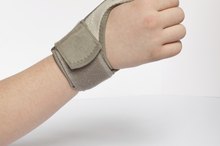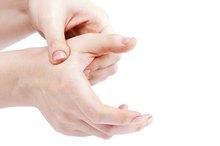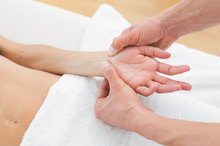Rehabilitation Exercises for a Dislocated Finger
A dislocated finger occurs when the bones of the finger are no longer aligned correctly at the joint due to trauma. This is a common injury that happens when the end of the finger is jammed, twisted, bent or overextended. This type of injury is seen often with sports-related activities. Symptoms include swelling, deformity and pain in the finger. A dislocated finger should be treated right away. Treatment involves your doctor resetting the bone in place and splinting the finger for immobilization. After the finger has been immobilized and the muscles and joint around the injury have had time to heal, your doctor will instruct you on when to start rehabilitation exercises for the finger.
Range of Motion
Increasing movement and flexibility of the injured finger is an important part of finger rehabilitation. To improve range of motion, use your uninjured hand to slowly bend the injured finger, holding the position for five seconds. Next, slowly straighten the finger, also holding for five seconds. Repeat this exercise 10 times, three to five times a day.
Object Pick-up
Exercises for Hypotonia
Learn More
Having a dislocated finger can make everyday activities, such as tying your shoes and writing, difficult. Using your thumb and injured finger, pick up small objects like marbles, buttons or coins to improve these motor skills.
Finger Extension
To increase flexibility of the injured finger, place the injured hand on a table with your palm facing down and fingers straight. Lift each finger individually holding for five seconds. Do 10 repetitions, three times per day.
Grip Strengthening
Types of Finger Splints
Learn More
To strengthen the injured finger, make a fist with the injured hand. You may assist the injured finger into a fist if it does not bend on its own. Hold this position for five to 10 seconds. Repeat the exercise 10 times, at least three times per day. This exercise can also be done with a tennis or stress ball.
Adduction to Abduction
Starting with your fingers together, slowly spread your fingers as far apart as you can without inducing pain. Return to the starting position. Repeating this exercise 10 times, three times a day, will help increase range of motion.
Related Articles
References
Resources
Writer Bio
Temesha Aldridge started writing professionally in 2010. She is a medical transcriptionist who has written hundreds of clinical and surgical reports. Her knowledge in areas of health comes from writing medical reports for physicians as well as experiences gained from time spent as a medical specialist in the U.S. Army. Aldridge holds a certificate in medical transcription from Everett Community College.









